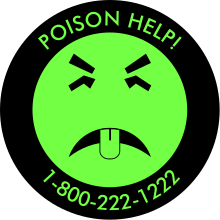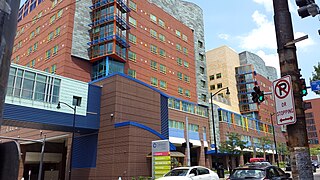
Mr. Yuk is a trademarked graphic image, created by UPMC Children's Hospital of Pittsburgh, and widely employed in the United States in labeling of substances that are poisonous if ingested.

Mr. Yuk is a trademarked graphic image, created by UPMC Children's Hospital of Pittsburgh, and widely employed in the United States in labeling of substances that are poisonous if ingested.
To help children learn to avoid ingesting poisons, Mr. Yuk was conceived by Richard Moriarty, a pediatrician and clinical professor of pediatrics at the University of Pittsburgh School of Medicine who founded the Pittsburgh Poison Center and the National Poison Center Network. [1] Moriarty felt that the traditional skull and crossbones representing poison was no longer appropriate for children; Congressman Bill Coyne later said that by the 1970s the symbol was "associated with swashbuckling pirates and buccaneers rather than with harmful substances." [2]
The design and color were chosen when Moriarty used focus groups of young children to determine which combination was the most unappealing. Possible expressions were "mad" (crossed eyes and intense expression), "dead" (a sunken mouth and Xs for eyes), and "sick" (a sour expression with the tongue sticking out). [3] Children were asked to rank the faces according to which they liked the best, along with the skull and crossbones, and the "sick" face was least popular. [3] The shade of fluorescent green that was chosen was christened "Yucky!" by a young child and gave the design its name. [2]
In 1971 the Pittsburgh Poison Centre issued the Mr. Yuk sticker. Over the next few years, Mr. Yuk stickers were used nationwide to promote poison centres in the United States of America. [4] The stickers usually contained phone numbers of poison control centers that may give guidance if poisoning has occurred or is suspected. Usually, Mr. Yuk stickers carried the national toll-free number 1-800-222-1222. In some areas, local poison control centers and children's hospitals issue stickers with local numbers, under license.[ citation needed ] A public service announcement was also produced in 1971 featuring a theme song. [2]
At least two peer-reviewed medical studies (Fergusson 1982, Vernberg 1984) have suggested that Mr. Yuk stickers do not effectively keep children away from potential poisons and may even attract children. [5] Specifically, Vernberg and colleagues note concerns for using the stickers to protect young children. Fergusson and colleagues state that "the method may be effective with older children or as an adjunct to an integrated poisoning prevention campaign". [6]
To evaluate the effectiveness of six projected symbols (skull-and-crossbones, red stop sign, and four others), tests were conducted at day care centers. Children in the program rated Mr. Yuk as the most unappealing image. By contrast, children rated the skull-and-crossbones to be the most appealing. [7]
Mr. Yuk and his graphic rendering are registered trademarks and service marks of the UPMC Children's Hospital of Pittsburgh, and the rendering itself is additionally protected by copyright. [8] The Children's Hospital of Pittsburgh of UPMC gives out free sheets of Mr. Yuk stickers if contacted by mail. [9]

A poison is any chemical substance that is harmful or lethal to living organisms. The term is used in a wide range of scientific fields and industries, where it is often specifically defined. It may also be applied colloquially or figuratively, with a broad sense.

A drug overdose is the ingestion or application of a drug or other substance in quantities much greater than are recommended. Typically it is used for cases when a risk to health will potentially result. An overdose may result in a toxic state or death.
A skull and crossbones is a symbol consisting of a human skull and two long bones crossed together under or behind the skull. The design originated in the Late Middle Ages as a symbol of death and especially as a memento mori on tombstones.

Hazard symbols or warning symbols are recognisable symbols designed to warn about hazardous or dangerous materials, locations, or objects, including electromagnetic fields, electric currents; harsh, toxic or unstable chemicals ; and radioactivity. The use of hazard symbols is often regulated by law and directed by standards organizations. Hazard symbols may appear with different colors, backgrounds, borders, and supplemental information in order to specify the type of hazard and the level of threat. Warning symbols are used in many places in lieu of or addition to written warnings as they are quickly recognized and more commonly understood.
Ingestion is the consumption of a substance by an organism. In animals, it normally is accomplished by taking in a substance through the mouth into the gastrointestinal tract, such as through eating or drinking. In single-celled organisms, ingestion takes place by absorbing a substance through the cell membrane.
A poison control center is a medical service that is able to provide immediate, free, and expert treatment advice and assistance over the telephone in case of exposure to poisonous or hazardous substances. Poison control centers answer questions about potential poisons in addition to providing treatment management advice about household products, medicines, pesticides, plants, bites and stings, food poisoning, and fumes. In the US, more than 72% of poison exposure cases are managed by phone, greatly reducing the need for costly emergency department and doctor visits.

The University of Pittsburgh Medical Center (UPMC) is an American integrated global nonprofit health enterprise that has 92,000 employees, 40 hospitals with more than 8,000 licensed beds, 800 clinical locations including outpatient sites and doctors' offices, a 3.8 million-member health insurance division, as well as commercial and international ventures. It is closely affiliated with its academic partner, the University of Pittsburgh. It is considered a leading American health care provider, as its flagship facilities have ranked in U.S. News & World Report "Honor Roll" of the approximately 15 to 20 best hospitals in America for over 15 years. As of 2016, its flagship hospital UPMC Presbyterian was ranked 12th nationally among the best hospitals by U.S. News & World Report and ranked in 15 of 16 specialty areas when including UPMC Magee-Womens Hospital. This does not include UPMC Children's Hospital of Pittsburgh which ranked in the top 10 of pediatric centers in a separate US News ranking.
Norton Healthcare is a Kentucky healthcare system with more than 40 clinics and hospitals in and around Louisville, Kentucky. The hospital and health care system is the Louisville area's third largest private employer, located at more than 140 locations throughout Greater Louisville, and Southern Indiana. The Louisville-based system includes six hospitals, one being in Madison, Indiana,, and with 1,993 licensed beds, eight outpatient centers, 18 Norton Immediate Care Centers, over 1,700 employees, over 1,500 employed medical providers, and approximately 2,000 total physicians on its medical staff.
Adolescent medicine also known as adolescent and young adult medicine is a medical subspecialty that focuses on care of patients who are in the adolescent period of development. This period begins at puberty and lasts until growth has stopped, at which time adulthood begins. Typically, patients in this age range will be in the last years of middle school up until college graduation. In developed nations, the psychosocial period of adolescence is extended both by an earlier start, as the onset of puberty begins earlier, and a later end, as patients require more years of education or training before they reach economic independence from their parents.

STAT MedEvac is a service of the Center for Emergency Medicine of Western Pennsylvania in Pittsburgh, Pennsylvania. The primary function of STAT MedEvac is to provide emergency medevac and air medical transport of critically wounded or sick civilians, either from emergency scenes or between hospitals. As of July of 2017, the organization also operates two ground ambulances for patients with severe injury or critical illness. STAT MedEvac is directed by a consortium of hospitals of the University of Pittsburgh Medical Center (UPMC) that include UPMC Children's Hospital of Pittsburgh, UPMC Altoona, UPMC Hamot, UPMC Mercy and UPMC Presbyterian Shadyside. STAT MedEvac's base of operations is in West Mifflin, Pennsylvania, at the Allegheny County Airport. With 18 air bases across Pennsylvania, Maryland, New York, Ohio, and the District of Columbia, it is one of the largest single operated and dispatched air-medical service organizations in the United States.

UPMC Children's Hospital of Pittsburgh (CHP), popularly known simply as Children's, is part of the University of Pittsburgh Medical Center and the only hospital in Greater Pittsburgh dedicated solely to the care of infants, children, teens and young adults through around age 26. UPMC Children's also sometimes treats older adults that require pediatric care. The hospital is affiliated with the University of Pittsburgh School of Medicine and features a state-verified level 1 pediatric trauma center, one of four in the state. CHP also has a rooftop helipad for emergent transport of pediatric patients.
Medical toxicology is a subspecialty of medicine focusing on toxicology and providing the diagnosis, management, and prevention of poisoning and other adverse effects due to medications, occupational and environmental toxicants, and biological agents. Medical toxicologists are involved in the assessment and treatment of a wide variety of problems, including acute or chronic poisoning, adverse drug reactions (ADRs), drug overdoses, envenomations, substance abuse, industrial accidents, and other chemical exposures.

Carol Remmer Angle is an American pediatrician, nephrologist, and toxicologist. Angle is known as one of the nation's leading researchers on lead poisoning. She is professor emeritus at the University of Nebraska Medical Center (UNMC) in Omaha, Nebraska. Angle joined UNMC in 1954 and was one of the first women to serve as chair of an academic medical department (pediatrics). She also served as chief of pediatric nephrology, director of the pediatric intensive care unit, and director of medical toxicology. In 1957, Angle along with Dr. Matilda McIntire, founded one of the country's first poison control centers. Angle is a founding member and a prior president of the American Association of Poison Control Centers. For forty years, Angle served as an expert for NIEHS, National Institutes of Health and U.S. Environmental Protection Agency panels investigating heavy metal toxicity. Angle continues as a toxicology consultant, reviewer and editor.

The Poison Prevention Packaging Act of 1970 (PPPA); was signed into law by U.S. President Richard Nixon on December 30, 1970. It was enacted by the 91st United States Congress. This law required the use of child-resistant packaging for prescription drugs, over-the-counter (OTC) drugs, household chemicals, and other hazardous materials that could be considered dangerous for children.

Laundry detergent pods are water-soluble pouches containing highly concentrated laundry detergent, softener and other laundry products. Notable brands of these packs include All, Arm & Hammer, Gain, Purex, Persil and Tide. They first became popular in February 2012 when they were introduced by Procter & Gamble as Tide Pods.

Michael Weitzman is an American pediatrician specializing in public health and policy. He is known for his research focusing on the social and environmental determinants of child health. He has published over 150 articles in medical and scientific journals on the damaging effects of second-hand smoke, lead exposure, and countless other determinants of children's health and behavior. From 1999-2005 he served as the executive director of the Center for Child Health Research, a national research institute created by the American Academy of Pediatrics.

Mr. Ouch is a hazard symbol developed by the US’s National Electrical Manufacturers Association (NEMA) to represent electrical hazard within pad-mounted transformers. Unlike other high-voltage warning symbols, Mr. Ouch was specifically designed with young children in mind. It is part of NEMA Standard 260-1996, Safety Labels for Pad-Mounted Switchgear and Transformers Sited in Public Areas, which lays out design guidelines for a complete label design that incorporates the Mr. Ouch symbol.

Poisoning is the harmful effect that occurs when too much of a poison, or substance that is harmful to the body, has been taken. Poisons can be swallowed, inhaled, injected or absorbed through the skin. Poisoning is not to be confused with envenomation.

Like most detergent products, Tide Pods, a laundry detergent pod sold by Procter & Gamble (P&G) since 2012, can be deadly if ingested. Media reports have discussed how children and those with dementia could mistake laundry pods for candy and endanger their health or life by consuming them, and they were named an emerging health risk by the Centers for Disease Control and Prevention in 2012. Between 2012 and 2013, poison control centers reported over 7,000 cases of young children eating laundry pods, and ingestion of laundry pods produced by P&G had resulted in six deaths by 2017. In response to the dangers, P&G changed Tide Pod containers to an opaque design, introduced warning labels, and added a bitter-tasting chemical to the pod contents.
Sharon Louise Hillier is an American microbiologist. She is the Richard Sweet Endowed Chair in Reproductive Infectious Disease and vice chair of the department of obstetrics, gynecology and reproductive sciences at the University of Pittsburgh Medical Center (UPMC) and Magee-Women's Research Institute.